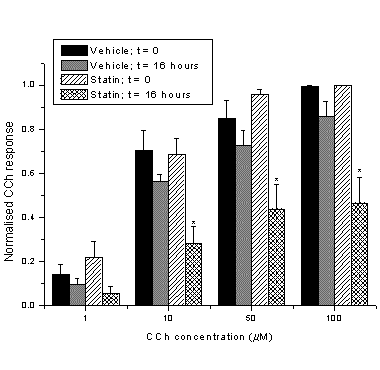| pA2 online © Copyright 2004 The British Pharmacological Society |
087P
GKT, University of London Winter Meeting December 2003 |
|
Lovastatin
inhibits contractions to carbachol in mouse anococcygeus, consistent
with inhibition of calcium sensitisation |
|
Rho-kinase (ROK)-mediated calcium sensitisation is an important component of excitation-contraction coupling in many smooth muscles including the mouse anococcygeus (Ayman et al, 2003). Activation of ROK is dependent upon association of RhoA with the plasma membrane. This association requires post-translational prenylation of RhoA, a modification that utilises metabolites of mevalonate, a product of the enzyme 3-hydroxy-3-methylglutaryl coenzyme A (HMGCoA) reductase. Inhibition of HMGCoA reductase by statins has been shown to reduce the association of RhoA with the membrane (Laufs et al, 1999). Statins might therefore be expected to inhibit ROK-mediated calcium sensitisation. We tested this hypothesis by studying the effects of lovastatin on carbachol (CCh)-induced contractions of the mouse anococcygeus.
Muscles from male mice (LACA; 25-35g) were set up for the recording of isometric tension. Concentration response curves to CCh were constructed before and after incubation with lovastatin (30 µM; 37 °C; 3 or 16 hours). Responses were normalised with respect to the maximum contraction obtained prior to treatment with the statin. Stock solutions (5 mM) of activated lovastatin were prepared from the inactive lactone as described by Jakóbisiak et al (1991). Time-matched controls were treated with vehicle alone. Results are presented as mean ± SEM for at least 4 observations. Statistical analysis was by Student's t-test or ANOVA with Student-Newman-Keuls post hoc test. P<0.05 was considered significant.
CCh produced concentration-dependent contractions of the mouse anococcygeus. As reported previously (Ayman et al, 2003) the ROK inhibitor Y27632 produced concentration-dependent relaxations (IC50 ~ 7 µM) of tissues pre-contracted with 50 µM CCh (EC90), illustrating the importance of the ROK pathway in the contractile response. Treatment of tissues with lovastatin for 3 hours reduced the maximum contraction to CCh (contractions to 50 and 100 µM CCh reduced to 0.82±0.03 and 0.87±0.03 respectively compared to 0.97±0.02 for both concentrations in time-matched controls). Responses to lower concentrations of CCh were also reduced, but these changes failed to reach statistical significance. Pre-treatment with the statin for 16 hours reduced the response to carbachol throughout the concentration range tested (Fig 1).

Figure 1: Normalised contractions to carbachol (CCh) in tissues treated with either vehicle or lovastatin (30 µM) for 16 hours. (*) indicates P<0.05 compared to time-matched control.
These results provide preliminary support for the hypothesis that statins might inhibit calcium-sensitisation and thus contractions in smooth muscle.
Ayman, S. et al
(2003) Br. J. Pharmacol., 139, 1532-1538.
Jakóbisiak et al, (1991) Proc. Natl. Acad. Sci.,
88, 3628-3632.
Laufs, U. et al (1999) J. Biol. Chem., 274, 21926-21931.